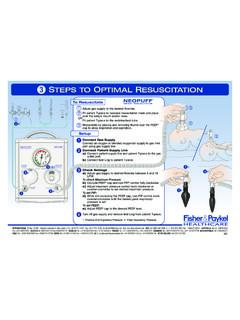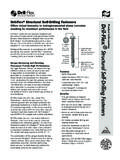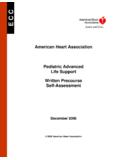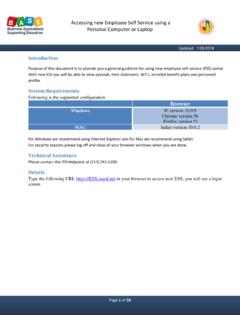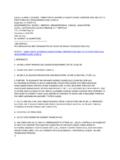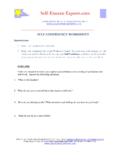Transcription of PALS Written 2011 Precourse Self-Assessment - …
1 E C C American Heart Association Pediatric Advanced Life Support Written Precourse Self-Assessment Questions and Answer Key for Students January 2012 2012 American Heart Association PALS Written 2011 Precourse Self-Assessment 2 2012 American Heart Association PALS Written 2011 Precourse Self-Assessment ECG Rhythm Identification The PALS ECG Rhythm Identification Self-Assessment test is designed to test your ability to identify rhythms you may encounter as a PALS provider. The rhythms in the list below are the core PALS rhythms that you should be able to identify during the PALS Provider Course teaching and testing stations. If you have difficulty with pediatric ECG rhythm identification, it is strongly suggested that you spend additional time reviewing basic pediatric arrhythmias before the PALS Provider Course.
2 Sources of information about pediatric ECG rhythm identification include the PALS Provider Manual and Learn: Rhythm Pediatric, available on This Self-Assessment test is composed of 13 multiple-choice questions. For all questions, select the single best answer. An answer may be used more than once. There are 3 Self-Assessment tests: ECG Rhythm Identification, Pharmacology, and Practical Application. Pediatric Rhythms: A. Normal sinus rhythm B. Sinus tachycardia C. Sinus bradycardia D. Supraventricular tachycardia (SVT) E. Wide-complex tachycardia; presumed ventricular tachycardia (monomorphic) F. Ventricular fibrillation (VF) G. Asystole H. Pulseless electrical activity (PEA) Rhythms 1 to 8: Core PALS Rhythms (select single best answer from rhythms A to H) Rhythm 1 (clinical clue: heart rate 214/min) PALS Written 2011 Precourse Self-Assessment 3 2012 American Heart Association Rhythm 2 (clinical clues: heart rate 44/min; no detectable pulses) Rhythm 3 (clinical clues: age 8 years; heart rate 50/min) Rhythm 4 (clinical clue: no detectable pulses) PALS Written 2011 Precourse Self-Assessment 4 2012 American Heart Association Rhythm 5 (clinical clue: no consistent heart rate detected; no detectable pulses) Rhythm 6 (clinical clues: age 3 years.)
3 Heart rate 188/min) Rhythm 7 (clinical clue: heart rate 300/min) PALS Written 2011 Precourse Self-Assessment 5 2012 American Heart Association Rhythm 8 (clinical clues: age 8 years; heart rate 75/min) PALS Written 2011 Precourse Self-Assessment 6 2012 American Heart Association PALS Written 2011 Precourse Self-Assessment Pharmacology The PALS Pharmacology Self-Assessment test is designed to test your knowledge of core drugs that will be used in the PALS Provider Course. If this Self-Assessment shows that your knowledge of the pharmacology and indications for these drugs is deficient, it is strongly suggested that you spend additional time reviewing basic resuscitation drug pharmacology before taking a PALS course.
4 Sources of PALS drug inf ormation include the PALS Provider Manual and the 2010 Handbook of Emergency Cardiovascular Care for Healthcare Providers (ECC Handbook). The Pharmacology Self-Assessment consists of 11 multiple-choice questions. Select the single best answer. There are 3 Self-Assessment tests: ECG Rhythm Identification, Pharmacology, and Practical Application. 1. You are called to help resuscitate an infant with severe symptomatic bradycardia associated with respiratory distress. The bradycardia persists despite establishment of an effective airway, oxygenation, and ventilation. There is no heart block present. Which of the following is the first drug you should administer? A. Atropine B.
5 Dopamine C. Adenosine D. Epinephrine 2. Which of the following statements about the effects of epinephrine during attempted resuscitation is true? A. Epinephrine decreases peripheral vascular resistance and reduces myocardial afterload so that ventricular contractions are more effective B. Epinephrine improves coronary artery perfusion pressure and stimulates spontaneous contractions when asystole is present C. Epinephrine is contraindicated in ventricular fibrillation because it increases myocardial irritability D. Epinephrine decreases myocardial oxygen consumption PALS Written 2011 Precourse Self-Assessment 7 2012 American Heart Association 3. Initial impression of a 2-year-old female reveals her to be alert with mild breathing difficulty during inspiration and pale skin color.
6 On primary assessment , she makes high-pitched inspiratory sounds (mild stridor) when agitated; otherwise her breathing is quiet. Her SpO2 is 92% in room air, and she has mild inspiratory intercostal retractions. Lung auscultation reveals transmitted upper airway sounds with adequate distal breath sounds bilaterally. Which of the following is the most appropriate initial therapeutic intervention for this child? A. Perform immediate endotracheal intubation B. Administer an IV dose of dexamethasone C. Nebulize mg of albuterol D. Administer humidified supplementary oxygen as tolerated and continue evaluation 4. Which of the following most reliably delivers a high (90% or greater) concentration of inspired oxygen in a toddler or older child?
7 A. Nasal cannula with 4 L/min oxygen flow B. Simple oxygen mask with 15 L/min oxygen flow C. Nonrebreathing face mask with 12 L/min oxygen flow D. Face tent with 15 L/min oxygen flow 5. Which of the following statements about endotracheal drug administration is true? A. Endotracheal drug administration is the preferred route of drug administration during resuscitation because it results in predictable drug levels and drug effects B. Endotracheal doses of resuscitation drugs in children have been well established and are supported by evidence from clinical trials C. Intravenous drug doses for resuscitation drugs should be used whether you give the drugs by the IV, the intraosseous (IO), or the endotracheal route D.
8 Endotracheal drug administration is the least desirable route of administration because this route results in unpredictable drug levels and effects 6. Which of the following statements most accurately reflects the PALS recommendations for the use of magnesium sulfate in the treatment of cardiac arrest? A. Magnesium sulfate is indicated for VF refractory to repeated shocks and amiodarone or lidocaine B. Routine use of magnesium sulfate is indicated for shock-refractory monomorphic VT C. Magnesium sulfate is indicated for torsades de pointes and VF/pulseless VT associated with suspected hypomagnesemia D. Magnesium sulfate is contraindicated in VT associated with an abnormal QT interval during the preceding sinus rhythm PALS Written 2011 Precourse Self-Assessment 8 2012 American Heart Association 7.
9 You enter a room to perform an initial impression of a previously stable 10-year-old male and find him unresponsive and apneic. A code is called and bag-mask ventilation is performed with 100% oxygen. The cardiac monitor shows a wide-complex tachycardia. The boy has no detectable pulses, so compressions and ventilations are provided. As soon as the defibrillator arrives you deliver an unsynchronized shock with 2 J/kg. The rhythm check after 2 minutes of CPR reveals VF. You then deliver a shock of 4 J/kg and resume immediate CPR beginning with compressions. A team member had established IO access, so you give a dose of epinephrine, mg/kg ( mL/kg of 1:10,000 dilution) IO, when CPR is restarted after the second shock.
10 At the next rhythm check, persistent VF is present. You administer a 4 J/kg shock and resume CPR. Based on the PALS Pediatric Cardiac Arrest Algorithm, what are the next drug and dose to administer when CPR is restarted? A. Epinephrine mg/kg ( mL/kg of 1:1,000 dilution) IO B. Atropine mg/kg IO C. Amiodarone 5 mg/kg IO D. Magnesium sulfate 25 to 50 mg/kg IO 8. Parents of a 1-year-old female phoned the Emergency Response System when they picked up their daughter from the babysitter. Paramedics perform an initial impression revealing an obtunded infant with irregular breathing, bruises over the abdomen, abdominal distention, and cyanosis. Assisted bag-mask ventilation with 100% oxygen is initiated.


